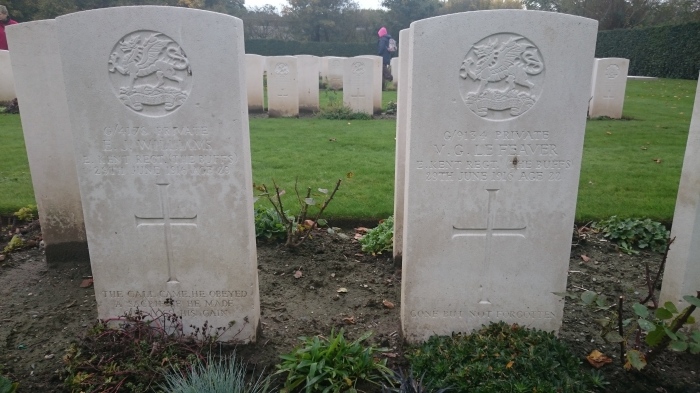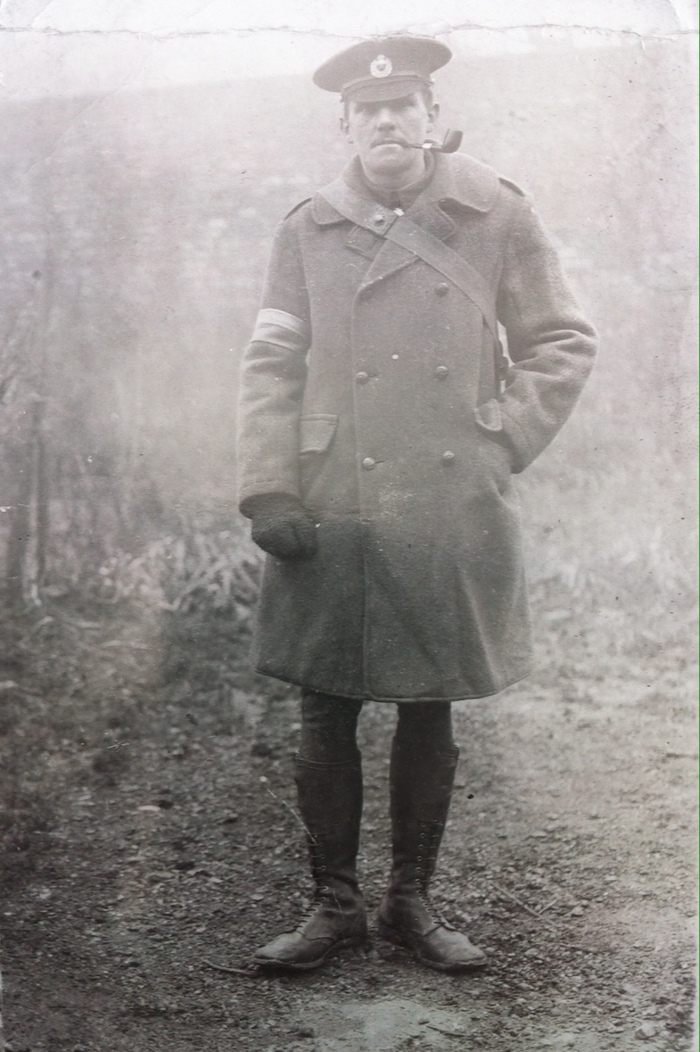The 8th Battalion Buffs at Ploegsteert
28th June 1916

Victor George Le Feaver and Edward James Williams now lie in the Berks Cemetery Extension and who were both killed in action during a trench raid on 28th June 1916.
After the Battle of Loos my Great Grandfather’s Regiment, the 8th Battalion Buffs, had spent most of their time around La Panne and around Ypres.
Eventually they would end up going in and out of the line around Ploegsteert Wood, which had earned the nickname ‘Plugstreet’ by the troops who first took up residence there.
This area was generally considered a quiet area by Western Front standards and was used to train inexperienced troops or to put in units who had suffered terrible casualties to recover their losses.
On 23rd May 1916 the war diary records the first inkling that the battalion would be carrying out an operation to infiltrate the enemy’s trenches.
‘Colonel Lucas was informed by the 17 I.B. that we were to make a raid with a party of 2 officers and 50 men on enemy’s trenches during one week in June.’

A trench map of the area where elements of the 8/Buffs would carry out a trench raid on 28th June 1916. The raid went in at the road to the left of the position known as Back Shed.
Trench raids were an integral part of trench warfare and were carried out all through the war. However, they could have dire consequences for the men who faced each other across no-man’s land. They evolved in 1915 and were popular with the high command that would send orders down the line to carry them out.
Depending on the unit who was carrying them out depended on how successful they could be but where you were could also have a bearing on them. Many units, friend and foe, operated a ‘live and let live’ policy. So in those sectors that were considered quiet it could be to the detriment of living a cushy life if you launched one. In a book written by the historian Tony Ashworth, who has studied this type of warfare, one veteran put it like this.
‘If the British shelled the Germans, the Germans replied, and the damage was equal; if the Germans bombed an advanced piece of trench and killed five Englishmen, an answering fusillade killed five Germans.’
From Trench Warfare 1914 – 1918 by Tony Ashworth
For other units who wanted to be recognised as elite regiments the trench raid was one way of showing their commanders that they were eager to engage the enemy and promotion could quickly follow for officers who led them, this type of officer is what Tony Ashworth has termed ‘Thrusters’. Men who went on them were often trained and therefore spent time away from the line and were given extra rations so there were perks to going on them.
They were planned and implemented for a number of reasons but the main ones were to capture prisoners or to gather intelligence. However, they were also used to keep the enemy on his toes and darkness would often be a time of fear for both sides as they tried to guard against them. For the attacker it was a time of abject fear as they attempted to infiltrate the enemy’s lines without being spotted and many of the raids ended in failure before they even got within sight of a trench. As already stated they often incited the enemy to punish their attackers and it was not uncommon for both sides to launch a retaliatory raid to restore their honour or to exact revenge.
There is no operation order present in the war diary to state how this was planned and for what reason. However, it is almost certainly to gather intelligence and to capture prisoners. Therefore, for the rest of May and the first part of June B’ Company along with other men from the 8/Buffs as well as supporting units such as the signallers from the battalion trained for the raid.
However, as the war moved into June 1916 and prior to the day the that the raid was launched the Germans decided to attack the British lines with gas. This occurred on 17th June 1916 and the first inkling that something was happening was when an alert for gas went up.
The Buffs official history had this to say about this attack:
‘On 17th June, about midnight, there arose a cry of ‘gas’ and the S.O.S. signal went up from the Royal Fusiliers who were on the left of the Buffs and, almost at once, a brisk bombardment broke on our front-line. The gas itself arrived three to four minutes after the warning and lasted half an hour. However, it missed our companies in the front line, but spread somewhat over the reserve companies in the front-line, but spread somewhat over the reserves and headquarters.’
Luckily this attack did not amount to a full scale assault and the Buffs only had two men slightly gassed. On 22nd June the main part of the battalion moved from Bulford Camp, via Bailleul, to St Jeans Capelle where they were billeted in farms. However, the raiding party of 2 officers and 100 men were left at Petit Pont Farm to continue practising the raid which they continued to do up to 27th June.

The position where the 8/Buffs infiltrated the German Line. This is looking at the position towards the German line and Back Shed would have been in the field on the left.
Then, on 28th June 1916, the raid went in. The Buffs official history stating:
‘On the 28th June, then, a detachment of the Buffs under Lieuts. Anderson and temple, to prove the value of the rehearsals, carried out a raid on the German trenches at a point known as the Ash Road Barrier, which is near Ploegsteert. The men moved out in two parties so as to be in a position outside our wire at 11.31 p.m., at which moment an intense bombardment commenced, directed on the points to be assaulted. Under cover of this the men crept forward, the guns lifting fifty yards at a time. Unfortunately the thing failed as a surprise, but Anderson’s party succeeded in entering the enemy’s front-line trench and then, after a bomb engagement, the raiding party withdrew successfully, bringing back with them all their wounded and some much treasured trophies for the folks at home. The left party found the enemy’s wire in front of them still uncut and it withdrew when the recall signal sounded leaving one dead man. Lieut. Hall commanded the covering party, and Captain C.D. Gullick the whole operation. Three officers and a hundred men went over the top. Four men were killed and twenty wounded, and it is possible that the German loss was about the same.’
This account, as well as the reports in the war diary, conflict what actually happened in relation to the men killed. However, it can be ascertained by other means that the 8/Buffs lost three men killed that night. They were Private, G/9134, Victor George Le Feaver, aged 22, the son of John and Ellen E. Le Feaver, of Stile Bridge, Marden, Kent. Private, G/5421, Charles Mann was the husband of Florence Mann, of No 1 Row, 102 King Street, Great Yarmouth. So even though this blog relates to my Great Grandfather’s regiment we can link this story to Norfolk as well.
The final soldier to be killed was Private, G/4178, Edward James Williams who was the son of Rose Ellen Williams, of 5, Primrose Hill, Beach Street, Deal. Both Le Feaver and Williams now lie in the Berks Cemetery Extension but Mann has no known grave and is commemorated on the Menin Gate.
This is probably due to the fact that the after action reports that one man was shot when he shone a torch into a dugout. Mann’s body would not have been picked up by his comrades and so would have been buried by the Germans. Le Feaver had been in Flanders roughly the same amount of time as Walter and his service record survived the Blitz so we know he landed in France on 19th May 1915. Williams had served since 25th November 1914 and Mann since September 1915. His service record also survived and he also left a daughter who was almost two.

One of the panels that commemorate the men from the Buffs who fell in the Ypres Salient which includes Charles Mann from Great Yarmouth.
After this the 8/Buffs, along with the rest of the 24th Division, headed towards the Somme where they would see action in August 1916 and we will look at their experience in that month.








